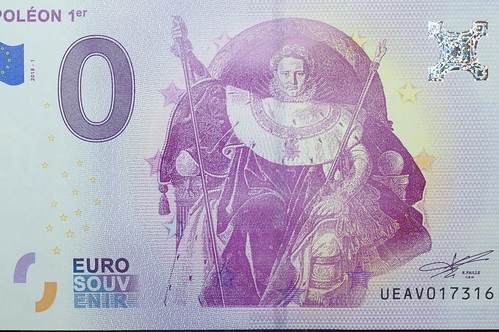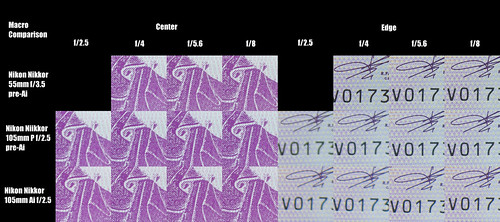Something I've wondered about for far too long is what, if any, meaningful difference is there between a dedicated macro and "normal" lenses when shooting close-up subjects? So, one dull morning I grabbed a few "supplies" and set about looking at what kind of answer I might come up with.
Setup -

Comparison Results -
[If you click on the image it'll take you to the Flickr hosting site. Once there, look at the file at full resolution. In many cases the differences between lenses is small and likely can't be seen until you take a squint at the comparison at 100 percent.]

Comments -
The Micro-Nikkor 55mm f/3.5 pre-Ai is a very fine optic. I've tested this on subjects at "normal" working distances and it's brilliant. I see for macro work that two things stand out. First, the lens is, indeed, very sharp from wide open. Second, the field is flat from wide open (just as advertised).
I'm enjoying this lens so much that I've brought it with me to the cote d'Azur where my wife and I are spending the winter. This lens is shouldering the bulk of the photographic duties while we're here.
I wasn't entirely sure what to expect from the 105mm Nikkors. These are of two slightly different optical designs and I wasn't sure if that would play a role in their macro performance. Hence this comparison, right?
For the 105mm Nikkors with an E2 extension tube I see the optical performance wide open suffers visibly. The centers are slightly soft and the edges are visibly soft (when viewed at 100 percent file resolution). But stop either lens down to f/4, and things clean up quite nicely. The centers become as sharp as the Micro-Nikkor and the edges are getting better. By f/5.6 and certainly at f/8, the center and edge resolutions look to be as good as the Micro-Nikkor.
Based on prior comparisons and what I learned about field curvature in many lenses I wondered how much that might come into play with the 105mm lenses used here. So I went back to the camera, set the focus magnifier in a corner of the field of view and changed the focus slightly. Both lenses were still soft in the corners wide open, but it wasn't quite as bad as the comparison images. At f/4 I could clearly see that if an absolutely flat optical field isn't required that the edges would be in clear good focus somewhere near the center focus point, but not exactly.
One of the things I learned in this comparison is that I might not "need" a 105mm Micro-Nikkor (either f/4 or f/2.8) when shooting close ups. If I made my living shooting 2D subject matter with the lens set wide open, well, yes, then I might see a good benefit by acquiring additional lenses.
But since I'm retired and am making these kinds of comparisons out of intellectual curiosity, I think my current Toy Collection remains sufficient to just about any task. Unless, that is, I happen to stumble upon a nice Micro-Nikkor 105mm lens at a rather attractive price. Then all bets would be off. Isn't there always room for "more" if it comes along for cheap?
Setup -
- Sony NEX-5T, 100ISO
- Big Beefy Manfrotto tripod
- Nikon lenses -
- Micro-Nikkor 55mm f/3.5 pre-Ai
- Nikkor 105mm f/2.5 P pre-Ai (early Sonnar design) with Nikkor F E2 extension tube
- Nikkor 105mm f/2.5 Ai (later modified Sonnar design) with Nikkor F E2 extension tube
- 0Euro Napoleon "currency" - for it's sharp image, text and paper fibers
- Sony RAW converter software used at it's default settings (no sharpening, no contrast, no exposure changes) to convert 100 quality jpg

Comparison Results -
[If you click on the image it'll take you to the Flickr hosting site. Once there, look at the file at full resolution. In many cases the differences between lenses is small and likely can't be seen until you take a squint at the comparison at 100 percent.]

Comments -
The Micro-Nikkor 55mm f/3.5 pre-Ai is a very fine optic. I've tested this on subjects at "normal" working distances and it's brilliant. I see for macro work that two things stand out. First, the lens is, indeed, very sharp from wide open. Second, the field is flat from wide open (just as advertised).
I'm enjoying this lens so much that I've brought it with me to the cote d'Azur where my wife and I are spending the winter. This lens is shouldering the bulk of the photographic duties while we're here.
I wasn't entirely sure what to expect from the 105mm Nikkors. These are of two slightly different optical designs and I wasn't sure if that would play a role in their macro performance. Hence this comparison, right?
For the 105mm Nikkors with an E2 extension tube I see the optical performance wide open suffers visibly. The centers are slightly soft and the edges are visibly soft (when viewed at 100 percent file resolution). But stop either lens down to f/4, and things clean up quite nicely. The centers become as sharp as the Micro-Nikkor and the edges are getting better. By f/5.6 and certainly at f/8, the center and edge resolutions look to be as good as the Micro-Nikkor.
Based on prior comparisons and what I learned about field curvature in many lenses I wondered how much that might come into play with the 105mm lenses used here. So I went back to the camera, set the focus magnifier in a corner of the field of view and changed the focus slightly. Both lenses were still soft in the corners wide open, but it wasn't quite as bad as the comparison images. At f/4 I could clearly see that if an absolutely flat optical field isn't required that the edges would be in clear good focus somewhere near the center focus point, but not exactly.
One of the things I learned in this comparison is that I might not "need" a 105mm Micro-Nikkor (either f/4 or f/2.8) when shooting close ups. If I made my living shooting 2D subject matter with the lens set wide open, well, yes, then I might see a good benefit by acquiring additional lenses.
But since I'm retired and am making these kinds of comparisons out of intellectual curiosity, I think my current Toy Collection remains sufficient to just about any task. Unless, that is, I happen to stumble upon a nice Micro-Nikkor 105mm lens at a rather attractive price. Then all bets would be off. Isn't there always room for "more" if it comes along for cheap?
No comments:
Post a Comment